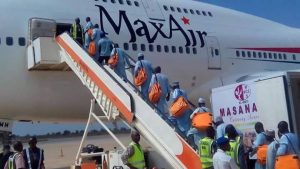HAJJ 2025: TRAVEL GUIDE AND THINGS YOU SHOULD KNOW AS YOU PREPARE FOR PILGRIMAGE (EPISODE 3)
By Leke Yusuf, Ajape Sefiu A.
The two previously released episodes (Episode 1 and Episode 2) provided us with information on the journey and essential details.
Recall that in those previous episodes, we made it known that it is crucial that pilgrims speak with their Hajj operators.
Also, there is a need to ask about the items that the operators will provide for them, as well as any other necessary item that they might need to bring with them.
Going further, this episode 3 will go deeper into our major focus in the second episode, which is the trip itself, starting from the take-off point to the holy land of Saudi-Arabia.
It is to be noted that you should, as much as possible, avoid making your own travel arrangements when going on Hajj or Umrah pilgrimage.
However, if circumstances force you to make your own travel plans by yourself, let your tour operator be fully aware of your travel plans, your arrival time, schedule and details.
Note that, other than the regular entry points of Medinah and Jeddah, Saudi-Arabia authorities also allow entry through certain airports within the Kingdom. The specific airports are usually stated every year.
Another important thing to note is your Miqat as you’re entering Saudi-Arabia. This is important so that you can know whether you will reach your Miqat while still in the aeroplane or if your Miqat is after you have arrived in Saudi-Arabia and you are moving by road or train, as the case may be, towards Makkah.
What exactly is Miqat?
According to the Prophet Muhammad PBUH, “It is a place beyond wherefrom no one can proceed to Makkah to perform Hajj and Umrah without putting on the Ihram; otherwise, he shall have to sacrifice.”
Miqat, which is Arabic meaning “a stated place,” is the line beyond which it is obligatory for pilgrims to intend the Ihram habiliments and beyond which no one may pass unless they are in the state of Ihram. Which is also why, a sacrifice of an animal must be made as atonement for Muslims who cross the border without observing Ihram.
“Allah’s Messenger, Prophet Muhammad (PBUH), had fixed Dhul Hulayfah as the Miqat for the people of Madinah; al-Juhfa for the people of Sham; and Qarn al-Manazil for the people of Najd; and Yalamlam for the people of Yemen. So, these (above mentioned) are the Mawaqit for all those living in those places, and besides them for those who come through those places with the intention of performing Hajj and Umrah and whoever lives within these places should assume Ihram from his dwelling place, and similarly, the people of Makkah can assume Ihram from Makkah.” [Sahih al-Bukhari]
This is why it is recommended that if you’ll reach your Miqat while still in the air, for the purpose of those who are going to perform Umrah first, in this case, the Hajj Tamattu, whereby you can bind the Umrah and the Hajj together, it is important that you have your ihram dress with you in your hand luggage and that it should not be checked-in.
However, if you are not going to cross the Miqat while in the air, you can check-in your ihram clothing. Depending on your flight, you can either change into the ihram clothing on the plane or at a transit point for those who will be using connecting flights.
The pilots of planes or airlines entering Saudi-Arabia usually make an announcement well ahead of reaching the Miqat to inform the passengers that they are approaching the Miqat and for those going to perform Umrah immediately while landing in Saudi-Arabia, that they need to make their intention (Niyya) for the Umrah.
Remember that the intention for Umrah is “Labbayka Allaahumma Umrah.” (O Allah, I have answered your call to perform the Umrah).
Meanwhile, after the intention (Niyya) has been made, you will keep reciting the Talbiyah below for as long as you can until you step into the confines of the sacred mosque in Makkah. The Talbiyah, however, is the same for both Hajj and Umrah.
Labbayka Allaahumma labbayk, labbayka laa shareeka laka labbayk. Inna al-hamdw a’l-ni`mata laka wa’l-mulk, laa shareeka lak.
Here I am, O Allah, here I am, Here I am, You have no partner, here I am. Verily all praise and blessings are Yours, and all sovereignty, You have no partner.
Furthermore, pilgrims should note that they cannot take their personal belongings into the Haram, the sacred mosque in Makkah.
The tour operators usually guide pilgrims on this and they usually first go to drop-off their personal belongings in their hotels or other designated places of residence that they will use during their stay in Mecca.
Likewise, the same thing is applicable to pilgrims who have also alighted at other designated airports and are approaching Mecca by road or train.
Pilgrims should at all times remember the sacred rule: “do not ever leave the group.” Even if you have to, in an emergency situation, like using the restroom, make sure you inform the coordinator and someone from your group of your whereabouts.
Also, pilgrims residential addresses during their stay in Mecca are always indicated on the hotels address cards, and this should be taken with them at all times in case they miss their way and have to get back to their hotels themselves.
They can easily show the address to the driver of the cab they’re taking, or better yet, show the address card to any Saudi policeman or other government officials who are usually willing to assist.
In addition, there is a tag-like wristband that the Saudi authorities would have tied around the wrists of pilgrims immediately after they enter into the kingdom. This tag contains important details about the group they are travelling with and their accommodations in case of any emergency; it should not be removed and must be on their wrist at all times.
We pray that Almighty Allah makes the Hajj trip easy for us. Ameen.
Watch out for the next episode of our Hajj Guide series.
Book your Hajj and Umrah Trips with 3SIXTYISLAM
Contact us at +2348155577038 or +2347066202861, and all our social media handles @3sixtyislam.


